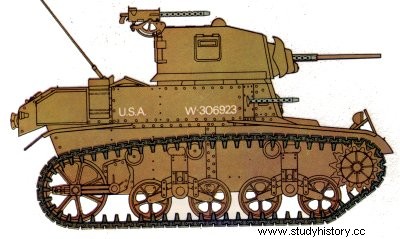
M3, M3A1, M3A2 and M3A3
country USA
Type: light tank.
Crew: 4 men.
Arming: a 37 mm M5 or M6 cannon; a coaxial M1919A4 .30 machine gun; 2 .30 machine guns in the side turrets; a .30 machine gun on the roof of the turret.
Shielding: minimum 10mm; max 44.5mm.
Dimensions:
length: 4.53m;
width: 2.23m;
height: 2.51 m.
Ground pressure: 0.74 kg/cm2.
Weight in combat order: 12.4 t.
Mass power: 20.7 hp/t.
Engine: Continental W-670 7 cyl. air-cooled gasoline radials, developing 250 hp at 2,400 rpm.
Performance:
road speed: 58 km/h;
off-road speed: 32 km/h;
autonomy: 112 km;
vertical obstacle. 0.6m;
clean break: 1.8m;
ford: 0.9m;
slope: 60%.
Service time: introduced in 1941 in the US Army. Widely used by the British Army and other Allied armies during World War II.
In June 1940, the standard light tank of the American army was the M2A4, standardized in 1939; the machine then represented the culmination of a research program undertaken with the M2A1 of 1935. The M2A4 weighed some 12 t, mounted a 37 mm under turret, carried riveted plate armor. This shielding was reinforced on a new machine, a modification which imposed the use of a lowered tensioning wheel.
This better protection, combined with better anti-aircraft defense, led to the standardization of the type, under the designation M3 light tank, in July 1940. The Continental 7-cyl. radials giving 250 hp was a legacy of the M2A4 but, in 1941, the shortage of these engines allowed the mounting of the Guiberson T-1020 on 500 M3 light tanks.
Following the combat experience acquired in North Africa in the ranks of the British army, the vehicle received an additional reserve of fuel in the form of two droppable drums transported outside. The M3 was produced in large quantities by the American Car and Foundry Company, with the company releasing 5,811 units by August 1942.
The M3A1 light tank mounted an improved turret, in homogeneous wrought armor (while the earlier armor was tempered only on the surface and therefore more fragile); rotation was
power-assisted, a gyro-stabilizer allowed greater shooting precision in motion; finally, the vehicle had a turret basket. The M3A1, stan dardized in August 1941, still employed the hull of the M3, in riveted plates. A pilot model with wrought steel hull and turret, the M3A1B1, launched an evolution that was to lead to the M5 light tank.
The model following the M3A2, was also to be a wrought steel assembly but similar to the M3A1 in all other respects. The M3A2 was not put into production but the American Car and Foundry produced 4,621 units of the M3A1, 211 of which were powered by a diesel engine. The M3A3, a much more complete redesign, made changes to the turret, hull and side turrets; it was deemed useful to continue producing it even after the start of the lines for its successor, the M5. The total production of the M3A3 reached 3,427 copies.
The M3 series included several experimental models, most of which tried out other automotive components. For the British army, the M3 was an extremely welcome reinforcement in North Africa in 1941 and 1942. Thereafter, it appeared in all the theaters of operations of the second world war but, if it survives in the memories, it is above all for his exploits in the desert, with the imperial forces in Burma, during the capture of Antwerp and with the American army in the Pacific. Its armament and its shielding were insufficient but its mobility and its robustness were worth to him the affectionate nickname of “Honey (“Chéri”) in the regiments of cavalry. Many units preferred it to the Daimler armored car in reconnaissance missions.
The M3 was the most widely used light tank of World War II and was produced in greater numbers than its two successors, the M5 and M24. A total of 13,859 units had rolled off the line by October 1943 even though the type had been declared obsolete in July of that year. Despite its speed and good off-road performance in the "cavalry" missions for which it was designed, the M3 presented little scope for development or adaptation.
